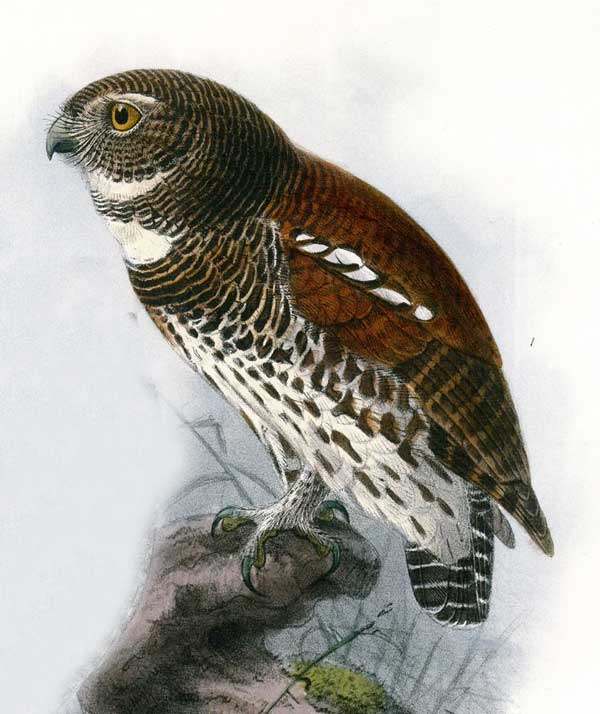Glaucidium castanonotum Cladus: Eukaryota Name Glaucidium castanonotum (Blyth, 1852) Reference Catalogue of the birds in the museum [of the] Asiatic Society p.39 Vernacular names The Chestnut-backed Owlet, Glaucidium castanonotum, is an owl which is endemic to Sri Lanka. This species is a part of the larger grouping of owls known as typical owls, Strigidae, which contains most species of owl. The other grouping is the barn owls, Tytonidae. Identification or Description The Chestnut-backed Owlet is small (19 cm) and stocky. It resembles the Jungle Owlet in shape, size and appearance but the upperparts, scapulars and wing coverts are mainly chestnut brown, with darker barring. The underparts are white with blackish shaft-streaks[1]. The facial disc is mainly brown and the eyes are yellow. There is a white neckband. Sexes are similar. There is no sexual dimorphism Distribution and habitat The Chestnut-backed Owlet is a common resident bird in the wet zone forests of Sri Lanka, and can be seen easily at sites such as Kitulgala and Sinharaja. Historical reports of its distribution by Legge include many parts of the southern half of Sri Lanka, especially the hills and the wet-zone low country extending to the outskirts of Colombo. In recent times, its range has shrunk greatly, and it is now found sparingly in the remaining forests of the wet zone and the adjoining hills up to 6500 ft ASL[1] Behaviour This species is diurnal and is frequently seen in the day, especially in the evening. The flight is deeply undulating. It can often be located by the small birds that mob it while it is perched in a tree. It frequents tops of tall trees, usually on steep hill-sides and hence is often missed[1]. It feeds mainly on insects, such as beetles, but also captures mice, small lizards, and small birds mostly when the young are being fed[1]. The call is a slow kraw-kraw and carries for a long distance[1]. It nests in a hole in a tree, laying two eggs. Notes 1. ^ a b c d e HENRY, GM 1971. A guide to the birds of Ceylon. Second edition. Oxford University Press, London. p. 200
* BirdLife International (2004). Glaucidium castanonotum. 2006. IUCN Red List of Threatened Species. IUCN 2006. www.iucnredlist.org. Retrieved on 11 May 2006. Database entry includes a brief justification of why this species is near threatened * Birds of India by Grimmett, Inskipp and Inskipp, ISBN 0-691-04910-6 Source: Wikipedia, Wikispecies: All text is available under the terms of the GNU Free Documentation License |
|

